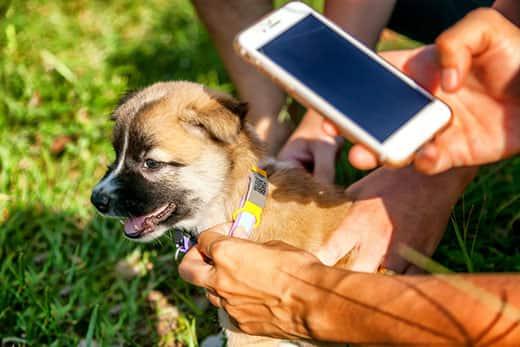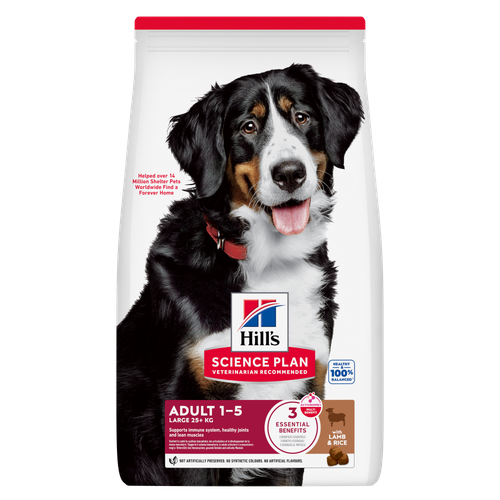
-
Find the right food for your petTake this quiz to see which food may be the best for your furry friend.Find the right food for your petTake this quiz to see which food may be the best for your furry friend.Featured products
 Small & Mini Mature Adult 7+ Dog Food
Small & Mini Mature Adult 7+ Dog FoodHill's Science Plan Small & Mini Breed Mature Adult Dog Food with Chicken is a complete pet food, specially formulated with ActivBiome+ Multi-Benefit Technology.
Tailored nutrition to support graceful ageing in small dogs. Specially made with a synergistic blend of nutrients for energy & vigor.Shop Now Perfect Digestion Small & Mini Adult Dog Food
Perfect Digestion Small & Mini Adult Dog FoodHill's Science Plan Perfect Digestion Small & Mini Breed Adult Dog Food with Chicken & Brown Rice supports ultimate digestive well-being & a healthy microbiome.
Shop Now Perfect Digestion Large Breed Puppy Food
Perfect Digestion Large Breed Puppy FoodPrecisely balanced nutrition with Hill's ActivBiome+ prebiotic blend actively contributes to supporting digestive health and overall well-being to help your pet feel their best
Shop NowFeatured products Kitten Food
Kitten FoodTender chicken chunks in gravy for kittens, with omega-3s for healthy eye & brain development and high-quality protein to support muscle growth. With balanced minerals to promote strong bones & teeth.
Shop Now Hairball & Perfect Coat Adult Cat Food
Hairball & Perfect Coat Adult Cat FoodHill's Science Plan HAIRBALL & PERFECT COAT Adult cat food with Chicken is specially formulated to effectively help avoid hairball formation in adult cats while promoting a beautiful coat. Thanks to its mix of essential Omega-6 fatty acids, this food benefits the cat's skin and fur keeping them healthy and shiny. Our Advanced Fibre Technology helps reduce hairballs by naturally promoting their passage through the gut. This food is formulated with high-quality protein for a perfectly balanced, great-tasting recipe.
Shop Now Hypoallergenic Dry Cat Food
Hypoallergenic Dry Cat FoodHILL'S SCIENCE PLAN Hypoallergenic Adult cat food with egg & insect protein is a complete pet food for adult cat 1–6 years old. It's formulated for cats with delicate skin and stomach, with limited high quality novel protein sources & no grain.
Shop Now -
Dog
- Dog Tips & Articles
-
Health Category
- Weight
- Food & Environmental Sensitivities
- Urinary
- Digestive
- Joint
- Kidney
-
Life Stage
- Puppy Nutrition
- Adult Nutrition
- Senior Nutrition
Cat- Cat Tips & Articles
-
Health Category
- Weight
- Skin & Food Sensitivities
- Urinary
- Digestive
- Kidney
-
Life Stage
- Kitten Nutrition
- Adult Nutrition
Featured articles Pet Food Storage Tips
Pet Food Storage TipsWhere you store your cat and dog food can make a big difference in the quality and freshness once it is opened. Here are some common questions and recommendations for optimal storage for all of Hill’s dry and canned cat and dog food.
Read More Understanding Your Pet's Microbiome
Understanding Your Pet's MicrobiomeLearn what a pet's microbiome is, how it contributes to your pet's gut & overall health, and why nutrition is important in maintaining healthy microbiomes.
Read More The Right Diet For Your Pet
The Right Diet For Your PetLearn what to look for in healthy pet food & nutrition, including ingredients, quality of the manufacturer, your pet's age, and any special needs they have
Read More -


Your dog getting lost is probably one of your worst nightmares. You love your pet and the thought of them being away from home, afraid and unsure of what to do, is heartbreaking for you. This is exactly why knowing what to do if you find a lost dog is important, so that you can keep them safe and reunite them with their own pet parents.
But do you know how to handle a dog who's lost? Should you call the police or animal control to ask for their help, or take the dog you found to your home? Use this guide to understand how to proceed if you find a lost dog.
Step 1: Be Careful in Your Approach
If you see a dog that appears to be lost, your first instinct might be to go toward it to help, but it's better to be cautious and look for clues as to whether the dog is showing signs of being distressed or aggressive. While your intentions come from a place of kindness, the dog may be fearful or experiencing a heightened sense of stress. If you're not sure what to do when you find a dog who seems agitated, it's often best to hang back.
The American Kennel Club (AKC) says, "Some signs to watch for include stiff body language, bared teeth and hair standing on end [...] Remember, a wagging tail only means an emotionally aroused dog, and it's no guarantee of a friendly attitude."

If you can approach the dog, do so calmly. However, you don't have to approach them to help, and you shouldn't if the dog doesn't seem to welcome your behaviour. If you're able to, take a picture or video of the animal that may help with identifying the pet later.
Aggressive behaviours shouldn't be the only thing concerning you, either. The dog may have rabies or another illness that could make you very sick if you were bitten as you approached.
Step 2: Make Sure the Dog Is Safe
Assuming that you're able to approach the dog, and they feel safe in your presence, one of the best things you can do is to make sure the dog is safe and secure. This may mean taking them into your yard or securing them with a leash in the area where you found them. This ensures the pet won't run off again, giving you the chance to get in touch with their owner or animal control.
Just make sure not to let the dog you've found mingle with your own pets. You don't want either pet to feel threatened by the other's presence and act out of aggression. Even if you're convinced they'd get along, consider that the lost dog may not be up-to-date with their vaccinations. They could have parasites like fleas or ticks that you don't want passed on to your pet.
Consider additional care opportunities like providing them with a bowl of water. However, do not feed the dog. Because you are unfamiliar with this dog, they might have special diet considerations and you don't want to further exacerbate their already stressful situation by causing an upset stomach. If you are keeping them outside, make sure to keep them in a cool shaded area during warmer weather or in a place to keep warm in winter months.


Tasty Tips
Step 3: Check for Identification
Now that you have the lost dog contained, the first thing you should do is check to see if the dog has any identification that will point you in the direction of their owner. They may have a tag on their collar with information like their name and their owner's information, such as telephone number or even address. Even if an identification tag isn't present, the dog might be wearing a city-issued tag which could help the animal control department or shelter to identify whose pet it is.
You won't be able to tell if the dog has been microchipped, but if they have, the animal control officer, veterinarian or pet shelter technicians will scan it to see if they can match the dog you've found with their pet parent.
Step 4: Alert the Masses
Contact your network of family and friends on social media. Wondering what to do if you find a lost dog? Well, your friends and local community can help you spread the word that you're currently caring for a wayward pet. Similarly, if you weren't able to approach the dog because they were showing signs of aggression or anxiety, or simply because the dog was too skittish and ran before you could approach them, social media may be able to help.

Upload the video or images you took of the pet and post them to any local groups you belong to or pages you follow. Share the image on your own news feed and ask your friends to share on theirs. Don't forget to list any identifying information the images may not have picked up, as well as where and when you noticed the pet. The location is just as important as the description.
Step 5: Call the Right People
If you've found a tag with identification, it's time to reunite the dog with their pet parents. If there's a number, call it and let them know you've found the dog and that they're safe. If there's just an address, take your new furry friend for a drive to their home. Just be sure to keep them leashed and close by at all times. This isn't a scenario where you'll want to leash the pet to their front porch and leave. Their owner may have relocated or the dog might get loose before they come home if they still live there. If nobody's home, you can always try again another day.
If the dog has no identifying information, try contacting animal control, the police, a local shelter or even your vet's office. All will have a different way of approaching the situation. A shelter or veterinarian may advise you to bring the pet in to see if they have been microchipped, they'll be able to pull up the dog's owner information to contact them. Animal control might be your best bet if you don't know what to do if you find a lost dog who appears aggressive or ill and you've determined it's not safe to approach them on your own.
If it's after hours and animal control isn't open, many local police departments will help. If the dog is calm and approachable, you can bring them to a shelter for protection. If the lost dog has an injury and you're willing to help get them treatment, bring them into the vet's office.
You may decide to take the dog home with you if you have a space to keep them safe and comfortable while you look for the owner, and that's okay. If you do this, know that the AKC still recommends contacting your local shelters to share a description of the dog with them. According to the AKC, "Even if you choose to keep the lost dog with you rather than turning the dog over to a shelter, letting the shelter know you have the dog increases the owner's odds of finding you and therefore their lost pet."
There's no need to worry about what to do if you find a lost dog anymore. As long as you approach with caution, check for ID tags and call in help if needed, you'll be doing the right thing.


One of our staff authors prepared this article for you
Related products

Hill's Science Plan Small & Mini Breed Mature Adult Dog Food with Chicken is a complete pet food, specially formulated with ActivBiome+ Multi-Benefit Technology.
Tailored nutrition to support graceful ageing in small dogs. Specially made with a synergistic blend of nutrients for energy & vigor.

Hill's Science Plan Large Breed Adult Dog Food with Lamb & Rice is a complete pet food, specially formulated with ActivBiome+ Multi-Benefit Technology.
This food is specifically designed to fuel the energy needs of large breed dogs during the prime of their life.

Precisely balanced nutrition with Hill's ActivBiome+ prebiotic blend actively contributes to supporting digestive health and overall well-being to help your pet feel their best

Hill's Science Plan Perfect Digestion Small & Mini Breed Adult Dog Food with Chicken & Brown Rice supports ultimate digestive well-being & a healthy microbiome.
Related articles

Discover the causes, signs, and treatments of kidney disease in dogs and find methods of supporting your dog's kidney health. Learn more at Hill's Pet South Africa.

Discover how the field of dog science is giving us more and more insights into the inner workings of our furry best friends.

Learn about snake bites on dogs, including clinical symptoms to look for, what to do if you think your dog was bitten, and treatment & prevention options.

Dog obesity is a significant problem - learn more about helping your dog become trimmer and healthier through improved nutrition.

Put your dog on a diet without them knowing
Our low calorie formula helps you control your dog's weight. It's packed with high-quality protein for building lean muscles, and made with purposeful ingredients for a flavorful, nutritious meal. Clinically proven antioxidants, Vitamin C+E, help promote a healthy immune system.
Put your dog on a diet without them knowing
Our low calorie formula helps you control your dog's weight. It's packed with high-quality protein for building lean muscles, and made with purposeful ingredients for a flavorful, nutritious meal. Clinically proven antioxidants, Vitamin C+E, help promote a healthy immune system.

